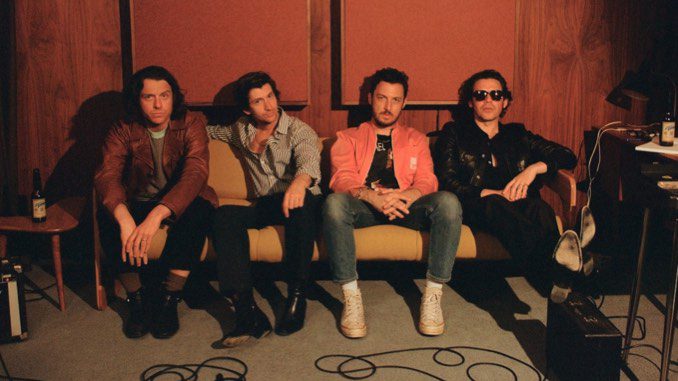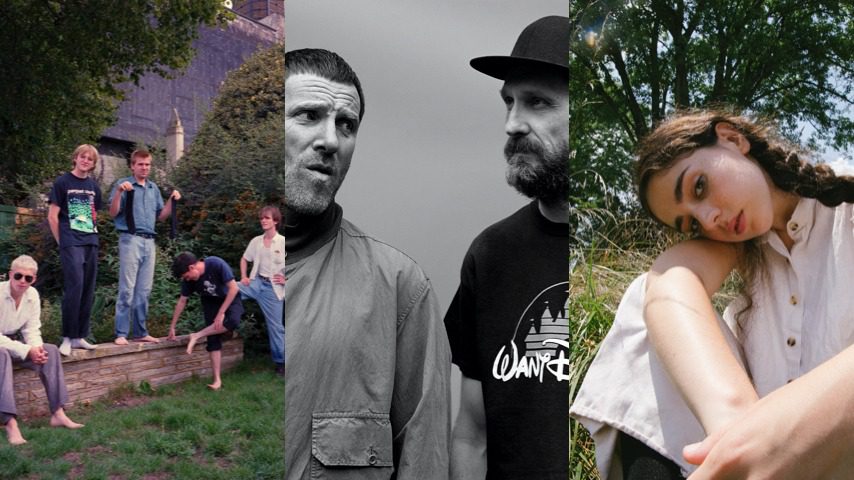Going from strength to strength is definitely not the story of every band in this industry, but it is the story of Arctic Monkeys, a once-riotous rock quartet from northern England made up of a bunch of humble, yet charismatic lads who, in not looking to make it, made it on a cocktail of sheer X-factor and unmistakable musicianship. There’s no overstating the caliber of the music this band has shaped throughout their 16-year tenure, piecing together a patchwork quilt of adolescent dreams and maturing fantasies that give the listener a breadcrumb trail tour through their growing up. In their new release, The Car, singer and songwriter Alex Turner admits that, even now, he’s got a lot of growing up to do. It’s an album that forces your mind to a place of reminiscence, smacking it with a palpable nostalgia that screams, “How did we get here and when did it all happen?”
Arctic Monkeys continue to build an oeuvre to be proud of, with each album—as well as all their b-sides, live cuts, and all the other little gems—making good on their promise to take fans on a ride to new heights and through different experimentations of sound. I’m proud to say I grew up on this band, cut my teeth on their personal prescription of rock and roll, and have yet to be disappointed with one of their releases because, at the end of the day, their uniqueness and passion for their music is enough to keep anyone with a taste for unabashed rock coming back. When you think about all they’ve contributed to music, and to rock and roll, over the course of seven varied albums, it makes sense that they still feel compelled to create and play in the sandbox where their most idiosyncratic ideas come to life. The Car is just the latest example, but on the occasion of its exciting recent release, I sat down to rank the band’s seven albums—and trust me, it wasn’t easy.
7. Suck It and See
Arctic Monkeys’ fourth album is a mellow, meandering walk through London’s Hampstead Heath on a sunny morning just as much as it’s getting ripped at the pub outside the park’s entrance after breaking a fresh sweat. Like every single record the band has put out, it has an unnatural amount of catchy songs on it, ones that live on some of my most coveted playlists and make appearances in new ones on the regular. This album definitely makes you wonder how someone could write so many good songs time and time again, with tracks like “She’s Thunderstorms” and “Piledriver Waltz” giving off a carefree, blazing-sunset air that makes this album feel worthy of its original early-summer release. That said, the band generally play to their strengths on Suck It and See, bringing things around to a more grounded rock sound after the gloom and doom of Humbug. Even the more easy listening-style tunes on this record have origins dating all the way back to the first album’s tracks like “Riot Van” and, to an extent, “Mardy Bum.” The more rock-heavy songs, like “Library Pictures” and “Brick By Brick,” also add to the record’s summer feel, but on the whole, Suck It and See isn’t as cohesive as the band’s other releases, and is ultimately more forgettable than the rest when looked at as a standalone work.
6. Favourite Worst Nightmare
It feels a bit strange ranking the band’s second album, Favourite Worst Nightmare, so low on this list. It’s a personal favorite of mine, potentially because of its tonal clues to what would come next, Humbug. Plus, it feels like the first album’s older brother, not just in chronology, but also in sound and theme. On this record, the boys have gotten older, the parties have gotten crazier, and when all the things you talked about the night before don’t make sense in the morning, well, that disorientation only gets more frequent. Favourite Worst Nightmare definitely makes sense slotted between the first and third records, sonically speaking, taking a step off the ledge of Whatever People Say I Am and allowing the band to test the waters of darker sounds, something that feels firmly in line with a band evolving into their young adulthood as individuals. On “This House Is a Circus,” the lyrics question what the party life has “done to [their] friends,” and on “If You Were There, Beware,” Turner addresses “a circle of witches, ambitiously vicious they are.” The messages match the sound, and it’s clear the band is exploring something new, but still resting on their laurels via songs like “Fluorescent Adolescent.” This sophomore entry is nearly as riotously rich as the first, but it keeps one foot in safe territory, relying on the positives of the first record, because of course it would. After all, you need a foundation to grow a fanbase on before you can start playing around with your imagination.
5. AM
In 2013, Tumblr and the girls who inhabited its digital wasteland fell in love with the fifth Arctic Monkeys album, AM. It was a cultural reset, to use a popular, yet meaningful phrase, and did something again that most bands can only hope to do once: bring a fresh, unique sound to the zeitgeist in a way that sticks. After bursting into the rock world with the distinctive sound of their first album, Arctic Monkeys raised the bar again with a harder, and in some ways, more commercially digestible rock sound that earwormed its way into every corner of the internet, as well as swaths of young girls’ swooning hearts. The second track, “R U Mine?” has become a classic in the way it envelops the listener in crooning guitar and fierce drums from the first seconds of its three-and-a-half-minute tenure. It’s a brash example of how the band revolutionized what rock music was at the time, in the same way The Strokes did in 2001, and the sound became definitive. It became a calling card for the band, a new-and-improved one that signified they had grown up as musicians and men.
4. The Car
Yes, she’s smack dab in the middle of this list, if you can believe. Arctic Monkeys’ latest release, their seventh album mysteriously titled The Car, says a lot about experimentation and how letting yourself evolve, free of judgment, nearly always pays off. Boy, is this album a treat for the ears. Capitalizing on all the great things about the album prior, Tranquility Base Hotel & Casino—and even a healthy sampling of Humbug on the track “Sculptures of Anything Goes”—The Car takes that sound a step further, and adds some impeccable strings for good measure. The result is a James Bond-esque musical novella that brings the story of Tranquility Base back down to Earth and expands on the possibilities its predecessor revealed to Turner, especially in the album’s first single, the hopeful and poignant “There’d Better Be a Mirrorball.” It’s an album that proves the band don’t ever intend to stay stagnant—I mean, hello, those strings, arranged by Turner himself—and though it certainly plays like Tranquility Base’s older brother, The Car is smart and direct with its lyrical self-awareness in a way that only time, experience and age can allow for.
3. Humbug
When Arctic Monkeys think outside the box is when they shine the brightest and do their best work. Their third album would arguably be the first time they did something completely new with their sound, revamping and dialing down the rock repertoire they debuted in England three years prior to Humbug’s release. With Queens of the Stone Age frontman Josh Homme at the production helm alongside their usual collaborator James Ford, Humbug brought a brooding sort of sinister, nearly suspicious rock and roll to the table. If you’ve heard any Queens of the Stone Age, you can imagine what kind of influence Homme’s music had on the band, and it shows clear as day in the album’s 10-song tracklist. Songs like “Dangerous Animals,” “Pretty Visitors” and “Potion Approaching” cement this mesh of sounds, Homme’s harsher rock with Turner and company’s quick wit and flippant guitars, and produce something entirely different than what the band had put out up to that point. The last minute of “Fire and the Thud” is a blessed example of the kind of heavy, contemplative rock Arctic Monkeys make on this record, with Turner wrapping you around his finger throughout the track before lashing out in those final moments. On this record, they kept their eye on the prize, focusing on this new sound and how to explore it, only harkening back to their easy-listening roots where it served them (particularly on “Secret Door” and “Cornerstone”). This is Arctic Monkeys in one of their most inventive moments, the first time when they were truly willing to step outside of their comfort zone to attempt something new. It’s always been a divisive album—literally, since its initial 2009 release—but no matter which way you slice it, Humbug deserves more recognition for its sheer force of will when it comes to being true to the music your gut tells you to make.
2. Tranquility Base Hotel & Casino
If Whatever People Say I Am exploded onto the scene with a freshness few have ever quite experienced, the band’s sixth album, Tranquility Base Hotel & Casino, did the same thing, only with decidedly quieter, more contemplative music. It’s worth noting this is the third time the band boldly reintroduced themselves with a new sound that sounded like a herald of the coming of a clever reinvention, a feat most act’s can only ever dream of achieving once. The sound on Tranquility Base, which is inherently lyrical and bathed in palpable science fiction-style influences, was so different from what fans were used to from the band that it garnered decidedly polarized opinions upon its release. Tranquility Base isn’t everyone’s cup of tea, but the record is a grower, revealing itself with repeat listens in a way that speaks to the kind of major departure it actually was. It defied fan expectations of guitar-influenced work from the band, daring to put the piano forward instead on tracks like “Batphone” and “The Ultracheese.” The concept album, which tells the story of a lonely man living in a trendy colony on the moon, is a delicate force that disguises its depths in its tenderness, and it is potentially the greatest experiment this band has ever conducted.
1. Whatever People Say I Am, That’s What I’m Not
When their debut album arrived in 2006, Arctic Monkeys were the kind of new blood no one guessed would pack such a punch. The reason this record is essentially betrothed to the number-one spot is simply because of how incendiary it was when it hit the airwaves. It was truly something different. It’s a chatty record, one that relies on fast talk and even faster guitars. Tracks like “Red Light Indicates Doors Are Secured” or “Perhaps Vampires Is a Bit Strong … ” capitalize on Turner’s quick tongue and flash fingers, as well as the band’s ability to keep up with the nearly boundless energy the young frontman radiated into the microphone and through amps. There’s no denying the album takes influence from so many incredible rock acts of the era—you know the ones: The Strokes, The Libertines, those types—but it also takes pages out of older books, too, like those of The Clash and Oasis. Ultimately, the cool thing about the record is it never stays in any of those places for very long, not before dragging itself back to the bar for another one, and one for that bird near the end, as well. It’s a concept album, which, as we now know, is not an anomaly for the Sheffield group, but at the time, the idea that a messy rock-and-roll group would debut with a concept record, no less one about the clubbing scene in northern England, was totally unheard of. Naturally, it struck a chord within the country for its catchy relatability, and the rest is history.
Further still, the album has aged pretty well, withstanding the test of time in a way that few harbingers of their era tend to do. Sure, it fits maybe too snugly in the category of nostalgia these days, but if there’s one thing humans will never stop doing in this life, it’s reminiscing. And what’s so wrong with remembering a time when Whatever People Say I Am songs were the soundtrack of that summer when you hit the clubs as many nights a week as you could get away with? Maybe we didn’t all live the kind of life the album chronicled, but we could all relate to the shame and disappointment of getting turned away by the club bouncer, or figuring out the girl at the bar we wanted to chat up is taken. Beyond its explosively unique sound and pure gut, Arctic Monkeys’ first album is grounded in real experience, and that makes its introduction to the world—and by and large, its place in the hierarchy of their discography—the most important of all of the band’s seven albums. Besides, there’s nothing like your first.
Lex Briscuso is an entertainment, film and culture writer who eats, sleeps, and breathes exceptional horror, sweeping dramas, and top-notch acting. She is a news desk writer at /Film and has bylines at FANGORIA, The Guardian, Shudder’s The Bite and EUPHORIA. Her horror radio show, YOUR NICHE IS DEAD, is live Mondays 5 p.m. ET. She tweets @nikonamerica.




